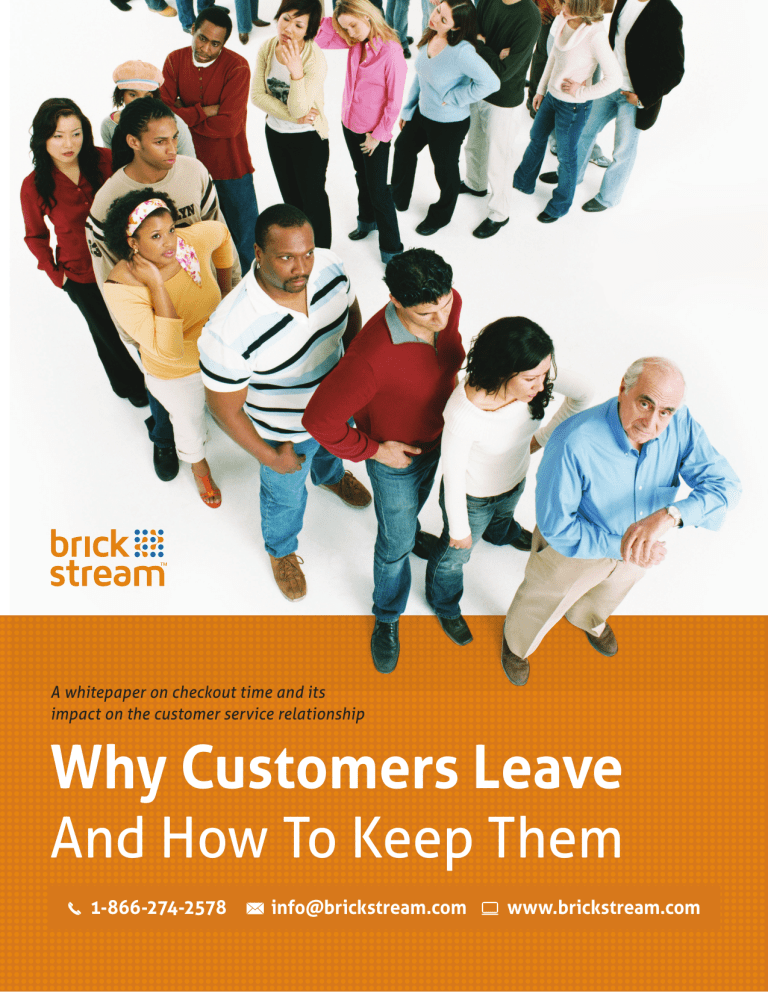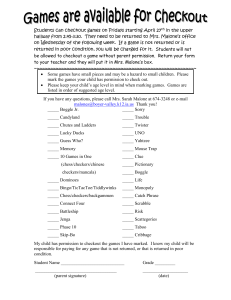Why Customers Leave

A whitepaper on checkout time and its impact on the customer service relationship
Why Customers Leave
And How To Keep Them
1-866-274-2578 info@brickstream.com www.brickstream.com
Executive summary
Customer service is key to retail success
Today’s retailers need to be able to balance a number of critical components to create perceived value—the Holy Grail that attracts loyal customers and encourages them to spend.
Success depends on the right mix of product selection, pricing and service. But in a multichannel world, brick-and-mortar stores are finding it more challenging to compete with the boundless product mix and price discounts offered online.
Customer service is a critical differentiator, and one that continues to present a huge opportunity for retailers due to one salient fact: Despite the number of buying channels now available to consumers, ninety percent of all retail sales transactions are still made in a brick-and- mortar location.
Even with competition from discounters and eCommerce, 70% of purchasing decisions and
90% of all purchasing transactions are still made in traditional brick-and-mortar settings
.
Checkout time dramatically impacts customer perception of service
In brick-and-mortar environments, checkout time has a huge influence on customer opinions about service. If lines are too long, customers won’t be willing to wait no matter how good the prices. This is an issue that retailers simply can’t afford to ignore, as it’s very costly to replace customers who take their business elsewhere. In fact, it can take up to 18 months before new customers become profitable.
Long checkout lines negatively impact sales in three ways:
Cart Abandonment resulting from customers who leave the checkout line because it is too long.
Put-Backs resulting from customers who, while shopping, see long lines and leave items on the shelves.
Expectations & Behavior
“Research on queuing has shown that, on average, people overestimate how long they’ve waited by about 36 percent.”
“Uncertainty magnifies the stress of waiting, while feedback in the form of expected wait times and explanations for delays improves the tenor of the experience.”
- “Why Waiting is Torture” by Alex Stone,
The New York Times, 8/18/12
Drive-Bys occur when customers don’t even enter a store because the lines are too long (or are perceived to be too long)
Why Customers Leave – And How to Keep Them | 2
Additionally, retailers can lose revenue through word of mouth. Only a small percentage of dissatisfied customers ever complain to the store or company, but they do tell their friends about negative experiences. And shoppers almost universally view waiting too long in line as a negative. According to a New York Times article by Alex Stone (“Why Waiting in
Line is Torture” August 18, 2012), “The dominant cost of waiting is an emotional one: stress, boredom, that nagging sensation that one’s life is slipping away”. This is not the experience that service-conscious retailers want to be giving their customers, especially when the competition is just a mouse-click away.
Research from cable & wireless and QM Group shows that:
5
A third of customers report they have abandoned a checkout line when forced to wait for more than five minutes.
5
Nearly half of all customers will actively avoid a retailer or brand in the future if the wait in line was longer than five minutes.
2 1
2
Customers become frustrated after two and a half minutes of no apparent progress in a queue.
It’s clear that queue management is an important element of customer service in brick-and-mortar environments. And to do this well, an accurate and efficient method of measuring wait times, and analyzing consumer perceptions of the experience, is critical.
Small changes can produce big results
By addressing checkout times and their impact on customer satisfaction, retailers can greatly improve perceived value, which leads to many other benefits. In fact, The American Customer
Satisfaction Index at Ten Years showed that even a 5% increase in customer satisfaction was related to increased stock values.
Retailers have applied technology to optimize many other aspects of operations, including supply chains, POS systems, location selection, call centers, and online customer “behavior.”
But they have not adequately applied technology to enhance the customer’s experience in brick-and-mortar locations. Appropriate and creative use of data capture and analytics technologies focused on understanding in-store customer behavior can provide causative insight into the drivers of customer satisfaction, including:
Proactive identification of potential sources of customer complaints
Real-life insight into customer behavior, taking into account store conditions and other important factors
Non-biased behavioral information (unlike traditional methods like surveys, POS data, or mystery shoppers)
Why Customers Leave – And How to Keep Them | 3
Queuing at the checkout to pay is the last thing a customer does before leaving a store. Creating frustration or a negative impression at this critical point can make them less likely to return. Retailers who monitor queues and make customer wait time a key performance indicator will have an edge. This advantage is realized through higher customer satisfaction and optimized labor costs.
Small changes can produce big results
By addressing checkout times and their impact on customer satisfaction, retailers can greatly improve perceived value, which leads to many other benefits. In fact, The American Customer
Satisfaction Index at Ten Years showed that even a 5% increase in customer satisfaction was related to increased stock values.
Retailers have applied technology to optimize many other aspects of operations, including supply chains, POS systems, location selection, call centers, and online customer “behavior.”
But they have not adequately applied technology to enhance the customer’s experience in brick-and-mortar locations. Appropriate and creative use of data capture and analytics technologies focused on understanding in-store customer behavior can provide causative insight into the drivers of customer satisfaction, including:
Queuing at the checkout to pay is the last thing a customer does before leaving a store. Creating frustration or a negative impression at this critical point can make them less likely to return. Retailers who monitor queues and make customer wait time a key performance indicator will have an edge. This advantage is realized through higher customer satisfaction and optimized labor costs.
Customers expect to be treated fairly. Managing the checkout process shows them that you value them, their time, and their business.
Customers value your store based on perceptions of how you value them
When it comes to brick-and-mortar retail, there are countless factors that impact customer satisfaction: price, location, inventory, sales staff, even the weather. Owners and managers have more control over some of these than others, but keeping them all in balance is what separates best-in-class performers from the also-rans. There are almost as many strategies and tactics for maintaining that balance as there are factors that can upset it. However, it is often the most basic parts of the equation that are addressed inappropriately, or worse, completely overlooked.
Time spent in checkout lines is a prime example. Although it is a common factor in every retail environment, the checkout experience in certain channels such as grocery, discounters, hardware, electronics, and drug stores can ruin a positive shopping event, salvage a poor one, or even determine whether customers walk through the door at all. For those reasons, this report will examine checkout time and the significant impact it has not only on customer service and satisfaction, but also on your bottom line.
“Despite being a $3 trillion global industry, retailing remains remarkably inefficient and volatility is the only constant.”
- David Joseph
Manager, Global Retail Strategy, SAS.
Why Customers Leave – And How to Keep Them | 4
Savvy retailers recognize the importance of customer service. A recent Brickstream poll shows that among respondents,
ranked it as their number one priority felt that their level of customer service was a key differentiator for their store said their organization had set explicit customer service standards
Clearly, they know that if customers aren’t satisfied, they’re not coming back.
In fact, research by Earl Naumann, Ph.D., author of Creating
Customer Values, shows that the influence of customer service on customer satisfaction is among the most critical factors in determining what he calls the Customer Service Value
Proposition. Naumann points out, for example, that Profit
Impact of Market Strategies (PIMS) studies have shown that customer perception of product and service quality is “the single best predictor of market share…”
Customers’ perceived value of your business is, in fact, related to how much they perceive they are valued. They have made an effort to patronize your store, but if they are left stranded in a checkout line they won’t continue to make that effort. From their point of view, they wouldn’t be left “standing around like cattle” if their business was truly appreciated.
“Winning retailers recognize the value of creating a differentiated in-store experience and while online shopping is growing, the in-store experience is a point of shopper interaction and inspiration—the place where personal connections can be made (or broken). The degree of interaction between shopper and store directly correlates to perceived value of shopping experience”
- “4 Retail Megatrends for 2013”
Retail / Consumer Goods Executive Justin
Honaman in Retail Info Systems News, 1/4/13
Why Customers Leave – And How to Keep Them | 5
As a retailer, always assume the customer satisfaction glass is “Half-Empty”
Today’s retailers must be more in tune with customer perceptions of their service. In an age where a single bad experience can be broadcasted to thousands via social networks, the impact of negative word of mouth can be significant. In fact, 48% of those surveyed in a study done by the Wharton School of Business and the Verde Group have avoided a store based on what they’ve heard about others’ negative experiences. Retailers also lose business due to
“drive bys,” customers who have turned away at the sight of long checkout lines. These are valued customers who literally never make it through the door.
Regardless of the reason for customer dissatisfaction, these factors negatively impact revenues. Not only do they drive away existing business, Naumann estimates that the expenses that go into generating new customers to replace those who have taken their business elsewhere can cause new customers to take up to 18 months before they become profitable.
The expense associated with acquiring a new customer can delay their profitability for up to 18 months.
A very small number of dissatisfied customers actually contact retailers with complaints.
6 % made formal complaints
31 % told family and friends about their negative experiences
48 % of those surveyed had avoided stores based on others’ negative experiences
“Retail Customer Dissatisfaction Study 2006” conducted by The Jay H. Baker Retailing Institute by the Wharton School of Business and The Verde Group.
Why Customers Leave – And How to Keep Them | 6
Traditional customer satisfaction metrics are inadequate
Because traditional in-store measurement techniques miss critical factors that go into shaping customer service and perceived customer value, they fail to give the complete picture of what’s required to succeed in today’s competitive retail environment.
For example, a Brickstream survey revealed that to assess customer service levels, nearly 65% of retailers use some form of mystery or secret shoppers, 60% use in-store observations and 58% use customer surveys. However, these methods use such small sample sizes that the results may not be statistically significant. Because they are based on a single instance rather than a continuous and objective measure, the results are not reliable benchmarks and cannot serve as meaningful measurements of change.
Survey participants are usually shoppers who experienced either the best or the worst customer service, meaning only the most extreme responses are included.
Results from secret shoppers / in-store observers only account for one-time or short-term occurrences. (These results also contain built-in observer bias).
Likewise, retailers often rely on point-of-sale data for measuring store performance, but those numbers miss valuable customer service information about:
1. Drive-bys
2. The rate of cart abandonment
3. Customers who waited in line so long that they don’t plan on coming back
These are the kinds of details needed to develop a comprehensive understanding of all factors impacting the retail environment—and that understanding is what is required to make meaningful improvements to staff knowledge, employee allocation, checkout times and customer satisfaction.
In its study, The Empowered Store, AberdeenGroup stated, “Retailers on a rapid growth path should be aware that their rudimentary time and attendance systems will prove inadequate as they reach critical mass… Just as it is critical to have the right product in the right place at the right time...best-in-class retailers use advanced techniques to insure they have the right employee in the right place at the right time.”
Why Customers Leave – And How to Keep Them | 7
The benefits of improved checkout
Given the importance of checkout time in shaping customers’ perceptions of service and value, it is critical that this phase of the store experience be a positive one. Naumann has pointed out that a single shopper, for instance, may shop at four stores in one month (a couple of grocery stores, a convenience store, and a drug store) for the same items.
If improvements in perceived value can help raise the share of expenditure from that shopper from 30 to 40% at a particular grocery store, sales could increase by one-third.
He goes on to say, “Studies have shown that the best predictor of share of spend is the customer’s perception of value
[including customer service]. The greater the customers’ perception of value, the greater the share of pocketbook that a firm will have.”
Technologically advanced metrics and analytics allow retailers to proactively identify customer service problems before they adversely affect customer satisfaction. In addition to tracking checkout performance, such systems can monitor employee to customer ratios and real-time behavioral information that goes far beyond transaction data. The results are better customer service, improved perceived customer value and ultimately a more profitable business.
Incremental improvement in checkout efficiency can pay impressive dividends.
4000 avg. daily customers
$50 avg. basket per customer
= $730 K per year revenue!
1% reduced cart abandoment
365 days / year
Why Customers Leave – And How to Keep Them | 8
Achieving high quality customer service
The best way to maintain and improve customer service in-store is to proactively manage the checkout process. Using available technology to capture appropriate metrics, along with real-time and historical data, eliminates the limitations and biases inherent in traditional methods.
Essential metrics to capture and understand
A full-scale customer service management solution should use technology to capture the following metrics for effective customer service management.
Queue Traffic Individual Wait Time Transaction Time Store Traffic
How many customers are in checkout lines at any given time?
How long does each customer wait in line?
Wait time averages can be misleading—as a 1 minute wait might be perceived as positive, while a wait of 10 minutes is perceived as negative. (The average in this case doesn’t reflect that one customer is happy and other is not.)
How long do customer transactions take, from
“hello” to “good-bye?”
Deliver the information where and when it’s needed
Real-time access to your checkout metrics is the key to consistently delivering a high level of customer service. A
“dashboard” or “alert” solution keeps store managers on top of the front-end experience whether they are in their office, the stock room, or taking care of other business. For example, if your corporate standard is to keep lines shorter than three customers, the system alerts the store manager to open a cashier station when the line reaches two customers. Or, if you promise to serve your customers in five minutes or less, the system will integrate transaction time data to provide predictive monitoring and send the alert before that threshold is reached.
How many customers have entered the store? How many are moving about within the store? How many are in line?
How many have exited?
Counting customers allows retailers to better predict wait times and adjust staff accordingly, before service breakdowns occur.
Why Customers Leave – And How to Keep Them | 9
Reporting should also be available on an hourly, daily, weekly and monthly basis. The data allows you to predict busy times and days and improve workforce management forecasts.
Regular monitoring of customer to employee ratios lets retailers find the “staffing sweet spot” where proper allocation of labor hours maximize conversion and profit.
Beyond simply tracking the number of customers walking through the door, an effective system should be able to combine traffic counting results with other data. When you know the average time customers spend in the store, the system can predict periods of peak activity at the checkout based on arrivals. Store managers can open cashier lanes before a rush and avoid lost sales due to long queues, put-backs or cart abandonment.
Are you experiencing heavier than expected customer volume or delays in checkout lines?
Automatic alerts provide advance warning so that customer service issues can be handled before they have a negative impact on customers’ in-store experiences.
Conclusion
Despite competition from other channels, brick-and-mortar retail locations still account for 70% of the public’s buying decisions and 90% of its transactions. Not surprisingly, customer service and all the elements that help create it remain critical components of overall retail success. Because perceived customer value can be so easily swayed in a negative direction, owners must pay constant attention to customer service issues like checkout time as soon as–or even before–they arise.
Context is extremely important when examining checkout time. Technologically advanced systems can be employed to provide continuous contextual results, whereas traditional measurement techniques present averages or only a snapshot of one moment and overlook elements like drive-bys and abandoned carts. The benefits of improving customer checkout time are far-reaching. Their impact can be seen in market share, customer retention, stock prices, and improved top and bottom line results.
About Brickstream
Brickstream is a leading provider of behavior intelligence solutions for understanding human behavior in the places where people shop, gather, work and play. Brickstream’s technology intelligently collects, integrates and analyzes data related to the actions of people as they enter, move through and exit an environment, delivering the equivalent of clickstream analytics for the brick-and-mortar world. Premier retailers, grocery chains, hospitals, banks and others use
Brickstream to understand more about their customers and visitors, and draw on the insight gained to enhance customer service, optimize resources, and maximize economic opportunities in real-time. Brickstream has the largest installed base of 3D smart devices worldwide, a global network of partners, and regional offices in Europe and Asia.
For more information on how Brickstream can provide you with the benefits of in-store behavior and queue intelligence, contact us at
1-866-274-2578 info@brickstream.com www.brickstream.com
Why Customers Leave – And How to Keep Them | 10








